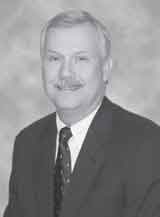From the Executive Director
Connectivity

If you spend much time in airports these days, you will see an amazing display of electronic connectivity going on around you. Cell phones, laptops, PDAs, and other cutting-edge devices are being used in a flurry of efforts to be "connected." Years ago, if you saw someone walking through the airport talking to himself, you assumed that you had just witnessed a little bit of mental instability on display. Now you routinely see people walking and talking out loud to no one in particular, but these people are merely using headsets to talk on their cell phones. This, of course, makes it harder to sort out who might be mentally unstable and who is connected. One might suggest that, given the hardships of today's air travel, they may be one and the same. Perhaps even cause and effect could be proven.
The need to be connected is not a new phenomenon, but the modes of connectivity have certainly changed. Please note here that I did not use the word "evolved." In my opinion, the new technologies we use today are not necessarily operating on a higher plane. They have changed, but may not have evolved to a higher form. In many ways, they have left us less connected than we need to be.
You may be tempted to dismiss me as a Luddite, someone who is totally opposed to technological innovations. Let me assure you that I am not categorically opposed to technological change, especially within the realm of electronic communication. I am opposed to placing too much faith in the ability to be connected via any electronic mode to the exclusion of traditional person-to-person contact. It is balance and synergy that I am advocating: using the best of the new and the old to improve the way we connect and communicate.
As an association, the AASV is blending the tools of electronic connectivity with the traditions of person-to-person interaction in a face-to-face setting. An example is the AASV annual meeting. We utilize both print and electronic media to connect our members with information about the meeting. The program appears in the Journal of Swine Health and Production, in the AASV e-Letter, on the AASV Web site, and in individual mailings. The meeting itself is based on person-to-person interaction. This occurs in the sessions, in the hallways, in side meetings, in the technical exhibits, and in the evening social events.
Another example is the work of AASV committees. No longer is it necessary for committee members to travel to a common site in order to achieve their goals. The use of conference calls has reduced cost and improved the efficiency and productivity of committees, as has the use of e-mail. Meetings via conference call can be scheduled rapidly and with little warning (as long as personal schedules permit). E-mails can rapidly transmit documents for discussion, input, editing, and ultimately approval.
However, there are some situations and issues that are best handled in person. E-mail is a great tool for the transfer of information, facts, and figures. E-mails are worthless in allowing one to see body language or hear verbal nuances. They do nothing to promote or support the personal intuition or insight gained from sitting across the table from someone. At worst, e-mail is a disaster when it comes to situations that require personal interaction. Some examples of these situations are intense negotiations, discussion of complex concepts, brainstorming of new ideas, difficult conversations, and critical decision-making that requires active, real-time dialogue. There are times when only a face-to-face meeting will suffice.
The key for an organization is to recognize the various modes of connectivity and to use each appropriately. The utility and limitations of each mode must be acknow-ledged and considered in our efforts to connect. Personal preferences come into play as members demand individualized care and service. Care must be taken to avoid embracing new technology just for the sake of its novelty.
An organization also has to continually be on the lookout for new ways to connect. Connectivity may be digital or it may be via traditional but unused person-to-person interaction. It may be a podcast on your MP3 player or it may be an educational meeting at a time and place we have never used before. Regardless of the mode of connectivity, it must create value for members.
The AASV mission is to increase the knowledge of swine veterinarians. It has never been enough to merely transfer information. Information is increasingly a commodity. Knowledge and its application create and maintain a competitive advantage. While the mission endures, the ways we increase knowledge through connectivity will continue to change and improve. Do you have a suggestion on how we can improve connectivity at AASV? Pick up the phone, send a fax, e-mail, instant message, letter, postcard ... well, you get the idea!
--Tom Burkgren
